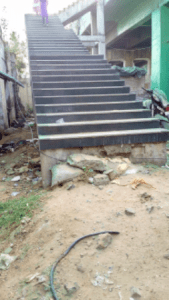Several months ago, as I travelled by suburban train passing under the Kodambakkam Road-Over-Bridge, I noticed something amiss about the footsteps on one side of the bridge. There were no handrails to prevent accidental fall from a height, a definite threat to users. Presuming that it was under construction, I kept a watch over it whenever I travelled by train.
On the morning of October 23, 2016, I paid a visit to the bridge by road from my residence at West Mambalam, merely out of curiosity. Strangely, the bridge appeared to have been completed nicely with granite steps of good quality, but with no apparent signs of any work underway to fix the handrails, except for some painting job. However, I found that the steps on all the three other sides of the bridge had handrails already fixed for safety.
This prompted me to take some photographs of the unfinished work in order to take up the matter with the Corporation. I uploaded the photos on the Chennai Corporation website under the “Online Public Grievance” section with a note that the steps without hand rails were precarious and posed a serious threat to the safety of commuters.
I even suggested that they should withhold payments to contractors, if any were pending, until the handrails were installed. To my pleasant surprise, the Corporation acted on it promptly by acknowledging my complaint and completed the work remaining in about four weeks’ time.
The purpose behind sharing this experience is to first acknowledge and appreciate the Chennai Corporation’s alacritous approach in responding to my complaint.
In their initial reply to my complaint, the authorities had said that the completion of the hand-rail fixing had been pending because of a court case related to that project and that it would be done as soon as it got vacated (see Corporation webpage snapshot of status below). This was executed as promised.
In this context, I must mention that I have registered a dozen or more complaints on various civic anomalies that I noticed from time to time, as I travelled around the city for various purposes. Not all were complaints, I even made some suggestions.
For instance, the sudden darkness bothered me whenever I passed through the Doraisamy subway. The inadequate light and visibility was because the under-roof of the railway-bridge had been left in cemented condition. I suggested that the civic authorities whiten this portion, so that the scattered daylight could provide better illumination to the public who pass through this subway. The Chennai Corporation after informing the Railways, did the job. The difference today is clear to anyone who happens to have visited the spot when the under-roof was only cemented.
All these experiences remind me of a quote from Johann Von Goethe: “Knowing is not enough; we must apply. Wishing is not enough; we must do”. I hope that these experiences will spur others to actively participate in improving the civic conditions of Chennai city.

